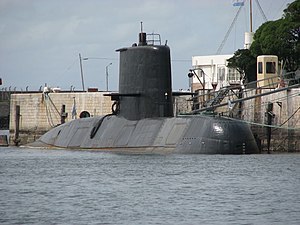 ARA San Juan (S-42) in 2007
| |
| History | |
|---|---|
| Name | San Juan |
| Namesake | San Juan Province, Argentina |
| Builder | Thyssen Nordseewerke, Emden, West Germany |
| Yard number | 465 |
| Laid down | 18 March 1982 |
| Launched | 20 June 1983 |
| Completed | 19 November 1985 |
| Commissioned | 19 November 1985 |
| Out of service | 15 November 2017 |
| Refit | 2014 |
| Homeport | Mar del Plata |
| Identification | Pennant number S-42 |
| Fate | Imploded; Sunk in the Atlantic Ocean[1] 15 November 2017 (with all hands) |
| General characteristics | |
| Class and type | TR-1700-class submarine |
| Displacement |
|
| Length | 67.30 m (220.8 ft) |
| Beam | 8.36 m (27.4 ft) |
| Draught | 7.34 m (24.1 ft) |
| Propulsion | |
| Speed |
|
| Range | 12,000 nmi (22,000 km) at 8 kn (15 km/h) surfaced |
| Endurance | 30 days |
| Test depth | 300 m (980 ft) |
| Complement | 37 |
| Sensors and processing systems |
|
| Armament |
|
ARA San Juan (S-42) was a TR-1700-class diesel-electric submarine in service with the Submarine Force of the Argentine Navy from 1985 to 2017. It was built in West Germany, entering service on 19 November 1985, and underwent a mid-life update from 2008 to 2013.
On 15 November 2017, San Juan went missing with 44 crewmen during a routine patrol in the South Atlantic off Patagonia. She was believed to have suffered an electrical malfunction, and a multi-nation search operation was mounted. Within hours of San Juan's last transmission, an acoustic anomaly consistent with an implosion was detected in the vicinity of the vessel's last known location. When the submarine was not located for a week, the crew were presumed dead by the Argentine government.[2] On 30 November, the search and rescue operation was abandoned.
The Argentine Navy reported on 16 November 2018 that the wreck of San Juan had been found at a depth of 907 metres (2,976 ft), 460 kilometres (290 mi) southeast of Comodoro Rivadavia.[3] The submarine's imploded wreckage was strewn over an area of 8,000 square metres (86,000 sq ft).[4][5]
- ^ "Submarino ARA San Juan: la Armada dio por finalizado el operativo de rescate y ya no busca sobrevivientes". La Nacion (in Spanish). 30 November 2017. Archived from the original on 30 November 2017. Retrieved 30 November 2017.
- ^ "Argentina Jews honor female submarine officer lost at sea". Times of Israel. 12 March 2018. Retrieved 12 August 2024.
- ^ "Ocean Infinity Locates the Missing Argentinian Submarine, ARA San Juan". Ocean Infinity. 17 November 2018. Archived from the original on 18 November 2018. Retrieved 21 November 2018.
- ^ "Argentine submarine: Missing ARA San Juan imploded, navy confirms". BBC News. 17 November 2018. Archived from the original on 17 November 2018. Retrieved 17 November 2018.
- ^ Politi, Daniel (17 November 2018). "Argentine Submarine That Vanished With 44 Aboard Is Found, Navy Says". The New York Times. Archived from the original on 17 November 2018. Retrieved 17 November 2018.